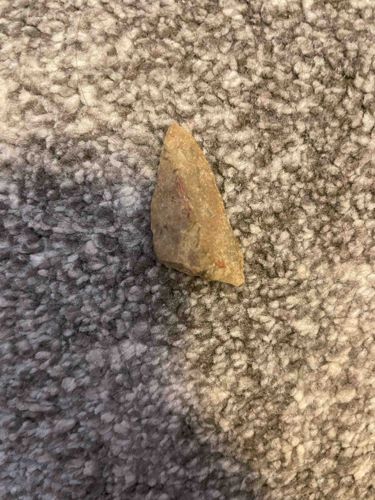
Fossilized Tooth Fragment
The item appears to be a fossilized dental element, specifically a tooth, likely from a prehistoric animal, possibly a dinosaur or large reptile. Its overall shape is conical and sharply pointed, tapering to an acute apex. The physical characteristics indicate a hard, rocky material, consistent with fossilization, displaying a predominantly light brown or tan coloration with subtle variations in shade. There are visible reddish-brown streaks or patches, particularly along one of the facets, which could be mineral staining, remnants of sediment, or possibly indications of the original tooth's internal structure. The surface shows a somewhat textured, slightly eroded appearance, common in natural fossils. While no distinct ridges or serrations are clearly visible, the general curvature and pointedness suggest it functioned as a predatory tooth. The condition appears to be stable, with no obvious signs of recent breakage or repair, though natural wear and erosion are present due to its age and the fossilization process. The size is difficult to ascertain precisely without a scale, but it appears small enough to be held in one's palm. There are no discernible manufacturing details, maker's marks, or signatures, as it is a natural specimen. Given its likely origin, it would belong to the Mesozoic Era or an equivalent geological period.
AI-Generated Appraisal Disclaimer
Estimated Value
$75-150
Basic Information
Category
Fossil/Paleontological Specimen
Appraised On
November 30, 2025
Estimated Value
$75-150
Item Description
The item appears to be a fossilized dental element, specifically a tooth, likely from a prehistoric animal, possibly a dinosaur or large reptile. Its overall shape is conical and sharply pointed, tapering to an acute apex. The physical characteristics indicate a hard, rocky material, consistent with fossilization, displaying a predominantly light brown or tan coloration with subtle variations in shade. There are visible reddish-brown streaks or patches, particularly along one of the facets, which could be mineral staining, remnants of sediment, or possibly indications of the original tooth's internal structure. The surface shows a somewhat textured, slightly eroded appearance, common in natural fossils. While no distinct ridges or serrations are clearly visible, the general curvature and pointedness suggest it functioned as a predatory tooth. The condition appears to be stable, with no obvious signs of recent breakage or repair, though natural wear and erosion are present due to its age and the fossilization process. The size is difficult to ascertain precisely without a scale, but it appears small enough to be held in one's palm. There are no discernible manufacturing details, maker's marks, or signatures, as it is a natural specimen. Given its likely origin, it would belong to the Mesozoic Era or an equivalent geological period.
Related Tags
Get Your Items Appraised
Instant estimates of your treasures with AI-powered instant appraisals